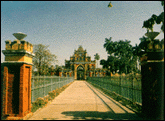
Impressive entrance Gate of Moharaja's Palace at Natore
About
40 km. from Rajshahi by roads is Natore, an old seat of Maharajas with
a beautiful palace now serving as the Uttara Ganabhaban (President's Official
residence of the northern region). It was residence of the Dighapatiya
Raj. It is situated amid well-kept grounds, surrounded by a fine moat.
The buildings are modern. They include a well-equipped guest-house, an
imposing gateway and a fine garden decorated with statues of white marble.
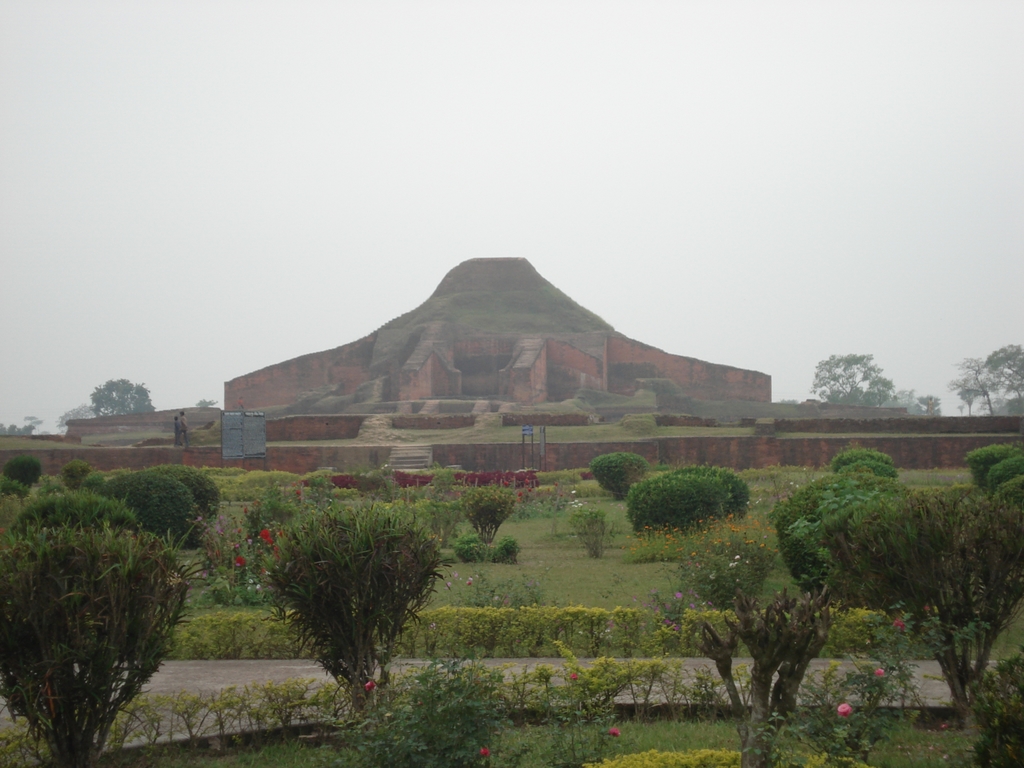
Paharpur
Paharpur
:
Paharpur is a small village 5 km. west of Jamalganj in the greater Rajshahi district where the remains of the most important and the largest known monastery south of the Himalayas has been excavated. This 7th century archaeological find covers approximately an area of 27acres of land. The entire establishment, occupying a quadrangular court, measuring more than 900 ft. externally on each side, has high enclosure- walls about 16 ft. in thickness and from 12 ft. to 15 ft. height. With elaborate gateway complex on the north, there are 45 cells on the north and 44 in each of the other three sides with a total number of 177 rooms. The architecture of the pyramidal cruciform temple is profoundly influenced by those of South-East Asia, especially Myanmar and Java. A small site-Museum built in 1956-57 houses the representative collection of objects recovered from the area.The excavated findings have also been preserved at theVarendra Research Museum at Rajshahi.The antiquities of the museum include terracotta plaques, images of different gods and goddesses, potteries, coins, inscriptions, ornamental bricks and other minor clay objects.
Paharpur is a small village 5 km. west of Jamalganj in the greater Rajshahi district where the remains of the most important and the largest known monastery south of the Himalayas has been excavated. This 7th century archaeological find covers approximately an area of 27acres of land. The entire establishment, occupying a quadrangular court, measuring more than 900 ft. externally on each side, has high enclosure- walls about 16 ft. in thickness and from 12 ft. to 15 ft. height. With elaborate gateway complex on the north, there are 45 cells on the north and 44 in each of the other three sides with a total number of 177 rooms. The architecture of the pyramidal cruciform temple is profoundly influenced by those of South-East Asia, especially Myanmar and Java. A small site-Museum built in 1956-57 houses the representative collection of objects recovered from the area.The excavated findings have also been preserved at theVarendra Research Museum at Rajshahi.The antiquities of the museum include terracotta plaques, images of different gods and goddesses, potteries, coins, inscriptions, ornamental bricks and other minor clay objects.
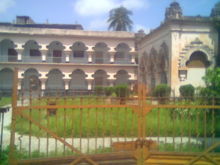
Varendra Research Museum
Chhota
Sona Mosque :
One of the most graceful monument of the Sultanate period is the Chhota Sona Masjid or Small Golden Mosque at Gaur in Rajshahi Built by one Wali Muhammad during the reign of Sultan Alauddin Husain Shah (1493-1519). Originally it was roofed over with 15 gold-gilded domes including the 3 Chauchala domes in the middle row, from which it derives its curious name. Varendra Research Museum : Situated at Rajshahi, this museum has a rich collection of objects of Mohenjodaro and also of 16th to 19th century A.D. This is devoted to the study of ancient history and culture. Its rich collections contain interesting objects of past Hindu, Buddhist and Muslim heritage. It is located at the heart of Rajshahi town and maintarned by Rajshahi University authority. The year of its formal establishment is 1910 A.D. Admission is free.
One of the most graceful monument of the Sultanate period is the Chhota Sona Masjid or Small Golden Mosque at Gaur in Rajshahi Built by one Wali Muhammad during the reign of Sultan Alauddin Husain Shah (1493-1519). Originally it was roofed over with 15 gold-gilded domes including the 3 Chauchala domes in the middle row, from which it derives its curious name. Varendra Research Museum : Situated at Rajshahi, this museum has a rich collection of objects of Mohenjodaro and also of 16th to 19th century A.D. This is devoted to the study of ancient history and culture. Its rich collections contain interesting objects of past Hindu, Buddhist and Muslim heritage. It is located at the heart of Rajshahi town and maintarned by Rajshahi University authority. The year of its formal establishment is 1910 A.D. Admission is free.
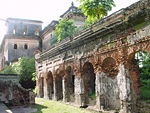
Ruins at puthia
Puthia
:
Puthia has the largest number of historically important Hindu structures in Bangladesh. The most amazing of the village''s monuments is the Govinda Temple, which was erected between 1823 and 1895 by one of the maharanis of the Puthia estate. It''s a large square structure crowned by a set of miniature ornamental towers. It''s covered by incredibly intricate designs in terracotta depicting scenes from Hindu epics, which give it the appearance of having been draped by a huge red oriental carpet. The ornate Siva Temple is an imposing and excellent example of the five-spire Hindu style of temple architecture common in northern India. The ornate temple has three tapering tiers topped by four spires. It''s decorated with stone carvings and sculptural works which unfortunately were disfigured during the War of Liberation. The village''s 16-century Jagannath Temple is one of the finest examples of a hut-shaped temple: measuring only 5m (16ft) on each side, it features a single tapering tower which rises to a height of 10m (33ft). Its western facade is adorned with terracotta panels of geometric design. Puthia is 23km (14mi) east of Rajshahi and 16km (10mi) west of Natore. Catch a bus from either town. Puthia is 1km (6mi) south of the highway.
Puthia has the largest number of historically important Hindu structures in Bangladesh. The most amazing of the village''s monuments is the Govinda Temple, which was erected between 1823 and 1895 by one of the maharanis of the Puthia estate. It''s a large square structure crowned by a set of miniature ornamental towers. It''s covered by incredibly intricate designs in terracotta depicting scenes from Hindu epics, which give it the appearance of having been draped by a huge red oriental carpet. The ornate Siva Temple is an imposing and excellent example of the five-spire Hindu style of temple architecture common in northern India. The ornate temple has three tapering tiers topped by four spires. It''s decorated with stone carvings and sculptural works which unfortunately were disfigured during the War of Liberation. The village''s 16-century Jagannath Temple is one of the finest examples of a hut-shaped temple: measuring only 5m (16ft) on each side, it features a single tapering tower which rises to a height of 10m (33ft). Its western facade is adorned with terracotta panels of geometric design. Puthia is 23km (14mi) east of Rajshahi and 16km (10mi) west of Natore. Catch a bus from either town. Puthia is 1km (6mi) south of the highway.
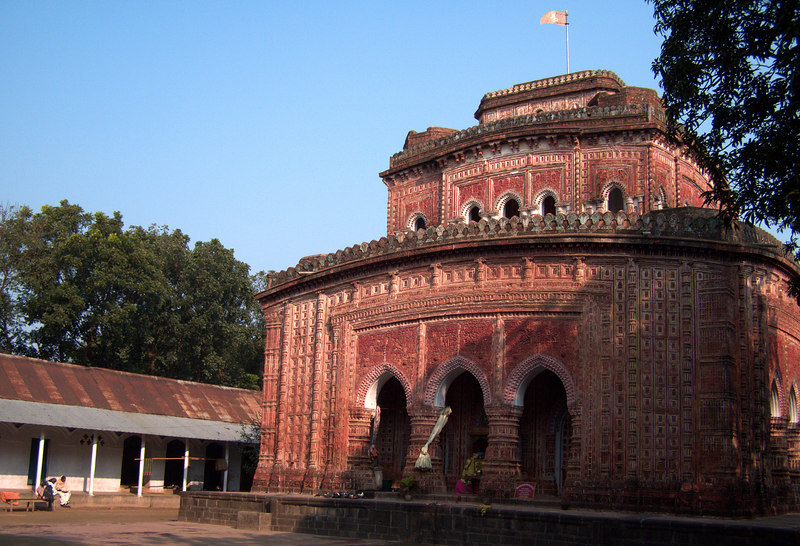
Kantangar
The Bagha
Mosque is located at Bagha, 25 miles southeast of Rajshahi in Bangladesh.
It was established in 1523 by Nashrat Shah, an independent Sultan of Bengal.
The mosque is depicted at the 50 Taka note of Bangladesh. The mosque was
built of brick on the bank of a tank and is surrounded by a brick wall.
It is fairly well preserved and is now protected. The mosque is known
for its beautiful terracotta ornamentation.[1] The natural surrounding
of the Bagha Mosque, with thousands of migratory birds visiting the adjacent
dighi (pond) can be another attraction for tourists. There is the shrine
of Auliah Hazrat Danishmand and his disciples at Bagha Mosque complex